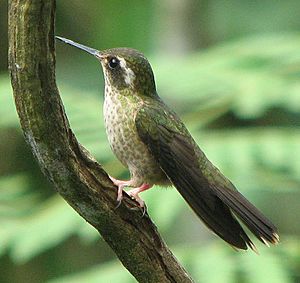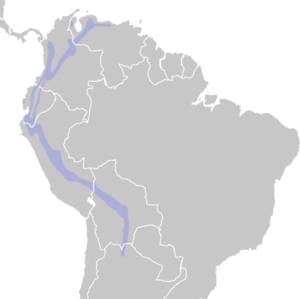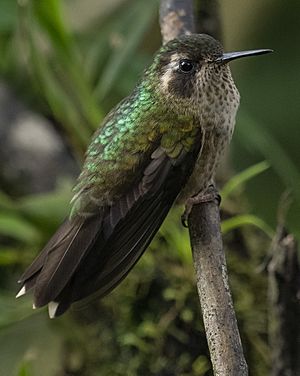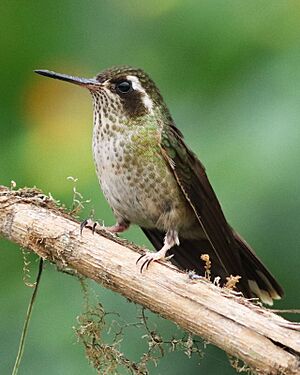Speckled hummingbird facts for kids
Quick facts for kids Speckled hummingbird |
|
|---|---|
 |
|
| Conservation status | |
| Scientific classification | |
| Genus: |
Adelomyia
|
| Species: |
melanogenys
|
 |
|
| Synonyms | |
|
Adelomya Mulsant & Verreaux, 1866 |
|
The speckled hummingbird (Adelomyia melanogenys) is a small, colorful bird. It is the only species in its group, called the genus Adelomyia. These hummingbirds live in the Neotropical cloud forests of the Andes mountains. You can find them in countries like Argentina, Bolivia, Peru, Ecuador, Colombia, and Venezuela. They usually live at high places, from about 1,000 to 2,500 meters (3,300 to 8,200 feet) above sea level. In Ecuador, they can be found even higher, up to 3,000 meters (9,800 feet). There's even a small group living closer to the coast in Ecuador.
Contents
What Does It Look Like?
Both male and female speckled hummingbirds look the same. This is called being monomorphic. They are about 8 centimeters (3 inches) long, from their beak to the tip of their tail. Their top feathers are a shiny green or bronze color. Their belly is pale with green and bronze spots, which gives them their "speckled" name. They have a black patch on their cheek, right below their eye, with a white stripe above it.
Where Do They Live?
Speckled hummingbirds live in the Andes mountains. They prefer mountain cloud forests. These forests are often covered in mist and clouds. They can be found across a wide range of altitudes. This means they live in different types of mountain forests.
Behavior and Lifestyle
The speckled hummingbird is a bird that likes to be alone. They do not live or travel in large groups. They also do not migrate, meaning they stay in the same area most of the time. However, some birds might move to lower areas when it's not breeding season.
Reproduction and Life Cycle
Male speckled hummingbirds do not help with building the nest or taking care of the young birds. The female hummingbird does all the work. She builds the nest, which looks like a cup made of moss and spiderwebs. It is lined with soft plant fibers. Nests are often found on mossy tree trunks or rocky ledges, sometimes even at the entrance of caves. They are usually built about 1 to 3 meters (3 to 10 feet) off the ground.
A female lays two white eggs. Each egg is very small, about 12.5 millimeters (0.5 inches) long. She sits on the eggs to keep them warm for about 17 to 20 days. This is called incubation. After the eggs hatch, she continues to keep the baby birds warm for about 7 to 8 days. Once the young birds are a bit older, she will perch near the nest instead of inside it. This might be to watch for predators. Speckled hummingbirds can build nests and have young all year round.
What Do They Eat?
Speckled hummingbirds do not gather with other birds to eat. They mostly drink nectar from flowers. They often feed on flowers that are close to the ground. They can drink from short, tube-shaped flowers. If a flower has a long tube, they might find a hole at its base to get the nectar. Like other hummingbirds, they also eat small insects. Insects give them extra nutrients that nectar does not provide. They might even collect tiny insects found on or near their nest.
How Are They Doing?
The speckled hummingbird is not considered a threatened species. It is quite common in the Andes mountains at medium elevations. In some areas, like near Cali, Colombia, there are many of them. This means they are doing well in the wild.
See also
 In Spanish: Colibrí jaspeado para niños
In Spanish: Colibrí jaspeado para niños




